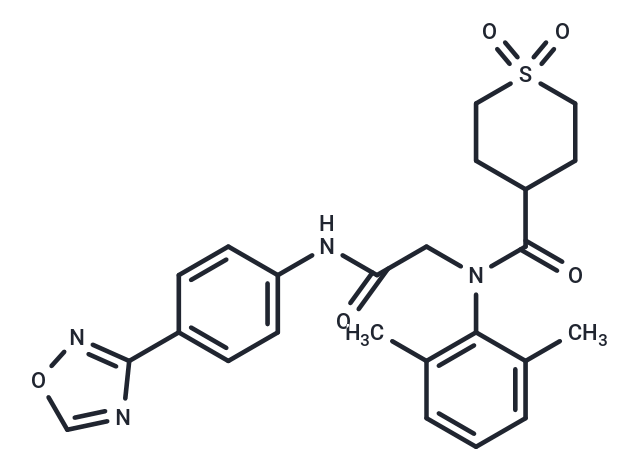Shopping Cart
Remove All Your shopping cart is currently empty
Your shopping cart is currently empty
Amenamevir (ASP2151) is a novel helicase-primase inhibitor that is active against varicella-zoster virus and herpes simplex virus types 1 and 2 (EC50: 14 ng/mL).

| Pack Size | Price | USA Warehouse | Global Warehouse | Quantity |
|---|---|---|---|---|
| 1 mg | $30 | In Stock | In Stock | |
| 5 mg | $68 | In Stock | In Stock | |
| 10 mg | $98 | In Stock | In Stock | |
| 25 mg | $163 | In Stock | In Stock | |
| 50 mg | $247 | In Stock | In Stock | |
| 100 mg | $372 | In Stock | In Stock | |
| 200 mg | $548 | In Stock | In Stock | |
| 1 mL x 10 mM (in DMSO) | $51 | In Stock | In Stock |
| Description | Amenamevir (ASP2151) is a novel helicase-primase inhibitor that is active against varicella-zoster virus and herpes simplex virus types 1 and 2 (EC50: 14 ng/mL). |
| Targets&IC50 | HSV2:15-58 ng/mL, Helicase-primase:14 ng/mL, HSV1:7.7-20 ng/mL |
| In vitro | The mean EC50s of Amenamevir against HSV-1 and HSV-2 are 14 (range, 7.7-20) and 30 ng/mL (range, 15-58), respectively, while those of acyclovir (ACV) is 29 (range, 18-38) and 71 ng/mL (range, 45-95), respectively. |
| In vivo | Amenamevir (ASP2151, 3-30 mg/kg/day) dose-dependently accelerates the reduction in virus titer. Amenamevir dose-dependently decreases both HSV-1 titers and lesion scores, irrespective of the dosing interval. Based on the correlation curves, HSV-1 growth is completely inhibited by Amenamevir (p.o.), and these PK parameters are estimated: Cmax in serum, 10,000 ng/mL or higher; AUC24h, 60 μg ? h/ml or higher; 21 to 24 h for T> 100. The mean concentration of Amenamevir in plasma at 5 days postinfection dose-dependently increases, with doses of 3 mg Amenamevir/g or higher significantly reducing the intradermal HSV-1 titer. |
| Cell Research | The antiviral activities of Amenamevir and ACV against HSVs are tested using a plaque reduction assay. Briefly, HEF cells are seeded into multi-well plates and incubated until they form a monolayer. After the medium is removed, the cells are infected with HSV-1 or HSV-2, and the plates are further incubated for 1 h at 37°C. The cells are washed twice with maintenance medium and then treated with the test compound (including Amenamevir) until clear plaques appear. The cells are then fixed with 10% formalin in phosphate-buffered saline, stained with a 0.02% crystal violet solution, and the number of plaques is determined under a light microscope. The EC50, which represents the concentration of test compound needed to reduce the plaque number by 50%, is calculated using nonlinear regression analysis with a sigmoid-maximum effect (Emax) model[1]. |
| Animal Research | Female hairless mice (HOS: HR-1, 7 to 8 weeks old) are infected with a suspension of HSV-1 strain WT51 (15 μL/mouse; titer, 2×108 PFU/mL) or CI-116 (15 μL/mouse; titer, 4×107 PFU/mL) in the dorsolateral skin stripped as a small square using a needle, under anesthesia. The day of HSV-1 infection is designated day zero postinfection. Total daily doses of 1, 3, 10, 30, or 100 mg/kg/day ASP2151 are orally administered to HSV-1-infected mice (n=5) for 5 days. Amenamevir (ASP2151) treatments are started 2 to 3 h after HSV infection either as a single daily dose (every 24 h, q24h) or as two (every 12 h, q12h) or three (every 8 h, q8h) divided doses. Lesion scores and intradermal HSV-1 titers are measured on day 5 postinfection[1]. |
| Synonyms | ASP2151 |
| Molecular Weight | 482.55 |
| Formula | C24H26N4O5S |
| Cas No. | 841301-32-4 |
| Smiles | Cc1cccc(C)c1N(CC(=O)Nc1ccc(cc1)-c1ncon1)C(=O)C1CCS(=O)(=O)CC1 |
| Relative Density. | 1.360 g/cm3 (Predicted) |
| Color | White |
| Appearance | solid |
| Storage | Powder: -20°C for 3 years | In solvent: -80°C for 1 year | Shipping with blue ice/Shipping at ambient temperature. | |||||||||||||||||||||||||
| Solubility Information | DMSO: 15 mg/mL (31.08 mM), Sonication is recommended. | |||||||||||||||||||||||||
| In Vivo Formulation | 10% DMSO+40% PEG300+5% Tween 80+45% Saline: 2 mg/mL (4.14 mM), Sonication is recommended. Please add the solvents sequentially, clarifying the solution as much as possible before adding the next one. Dissolve by heating and/or sonication if necessary. Working solution is recommended to be prepared and used immediately. The formulation provided above is for reference purposes only. In vivo formulations may vary and should be modified based on specific experimental conditions. | |||||||||||||||||||||||||
Solution Preparation Table | ||||||||||||||||||||||||||
DMSO
| ||||||||||||||||||||||||||
| Size | Quantity | Unit Price | Amount | Operation |
|---|

Copyright © 2015-2025 TargetMol Chemicals Inc. All Rights Reserved.